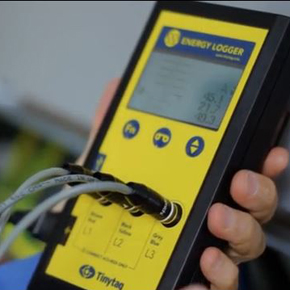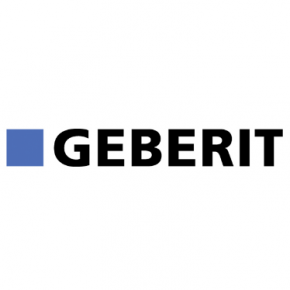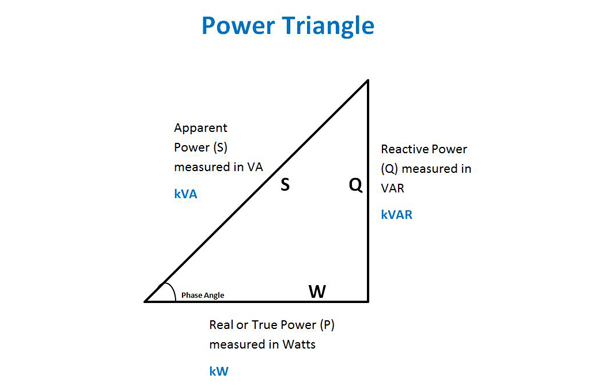
Why should energy managers monitor power factor?
Gemini Data Loggers explains why is is important to monitor power factor (PF) when observing overall energy use in high consumption facilities.
Power factor, or PF, is a measurement of how efficiently electrical power is consumed.
In manufacturing facilities, the operation of plant and equipment, such as motors, compressors, welding sets, and fluorescent lighting, can introduce additional currents called ‘inductive reactive currents’ into a site’s electrical supply.
The power dissipated in a load is the product of the voltage and current. If a load is purely resistive, the voltage and current are in phase and all the power can do useful work. If a load has a reactive component, the voltage and current are not in phase. The reactive load causes current to flow, but it can do no useful work.
The relationship between resistive and reactive power can be described by the power factor. A purely resistive load has a power factor of one and a phase angle of zero, because there are no electrical inefficiencies.
Meanwhile, a purely reactive load has a power factor of zero and a phase angle of 90.
The relationship between apparent, real and reactive power can be represented in the power triangle.
Most loads have a component of each: ideally, in terms of consumption, electrical efficiency would be around 1.00 PF. However, in a typical commercial or industrial site, this inductive loading can cause it to be reduced to around 0.80 PF.
Choosing an energy monitoring device that has the ability to measure power factor is important in gaining an accurate overall picture of energy usage and planning efficiency measures.
How can PF affect electricity costs?
Low power factors are undesirable. If a load has a low power factor, more current must be supplied by the utility company than is actually needed. This means heavier equipment, inefficient use of energy, and additional electricity costs.
Organisations with a poor power factor are likely to be charged a premium for power by the utility company.
In addition to saving energy and reducing costs, as the power factor of a system is improved, the release of electrical capacity means that the total current flow will be reduced. This permits additional loads to be added and served by an existing system.
Choosing efficient energy data loggers
When assessing overall energy efficiency, it is important to use an energy data logger that records power factor., in addition to single and three phase power usage.
The ability to measure PF in a facility will indicate how effectively electrical power is being used, enabling facilities to introduce corrective measures that can target the inductive reactive currents, counteract the inductive element of the load and increase electrical efficiency to nearer the ideal target of 1.00 power factor.
Power factors can be improved by the installation of new or specialist equipment, including dedicated integrated circuits.
To ensure an accurate measurement of power usage, it is important to choose an energy logger that measures both voltage and current usage and correlates the timing between the two to measure the power factor.
Tinytag Energy Data Logger
The Tinytag Energy Data Logger is a useful tool for identifying and evaluating energy saving measures.
The system monitors single and three phase power usage, and power factor. It can be used for spot checks, or left to record for longer periods to help build up energy profiles throughout an organisation.
Gemini Data Loggers,
Scientific House,
Terminus Road,
Chichester,
West Sussex,
United Kingdom,
PO19 8UJ
Phone: 01243 813000
Fax: 01243 531948
Visit Gemini Data Loggers' website
Visit Supplier's page
Latest news

30th April 2024
ASSA ABLOY Door Group strengthens offering with partnership
ASSA ABLOY Door Group is proud to announce a new internal restructure that sees the company joining forces with all comparable business units across Europe, the Middle East, India and Africa, to form a new global division – the ASSA ABLOY EMEIA Door Business Segment.
Posted in Access Control & Door Entry Systems, Architectural Ironmongery, Articles, Building Associations & Institutes, Building Industry News, Building Products & Structures, Building Services, Doors, Facility Management & Building Services, Restoration & Refurbishment, Retrofit & Renovation, Security and Fire Protection
30th April 2024
Geberit exhibiting at British Pig & Poultry Fair 2024
Bathroom and piping manufacturer Geberit will be exhibiting at the British Pig & Poultry Fair at NEC Birmingham (15 – 16 May 2024).
Posted in Articles, Building Industry Events, Building Industry News, Building Products & Structures, Building Services, Exhibitions and Conferences, Facility Management & Building Services, Innovations & New Products, Pipes, Pipes & Fittings, Plumbing, Retrofit & Renovation
29th April 2024
Hush: New Hushlay options offer acoustic upgrade potential
Leading UK acoustic systems manufacturer Hush Acoustics has introduced two additional variants of its Hushlay Soundmatting product.
Posted in Acoustics, Noise & Vibration Control, Articles, Building Industry News, Building Products & Structures, Building Services, Facility Management & Building Services, Floors, Innovations & New Products, Insulation, Restoration & Refurbishment, Retrofit & Renovation
29th April 2024
Digital Construction Week 2024 speaker programme announced
The programme at Digital Construction Week is carefully designed to help you keep up with the fast pace of innovation in the built environment.
Posted in Articles, Building Industry Events, Building Industry News, Building Products & Structures, Building Services, Exhibitions and Conferences, Innovations & New Products, news, Posts, Restoration & Refurbishment, Retrofit & Renovation, Seminars, Sustainability & Energy Efficiency
 Sign up:
Sign up: 